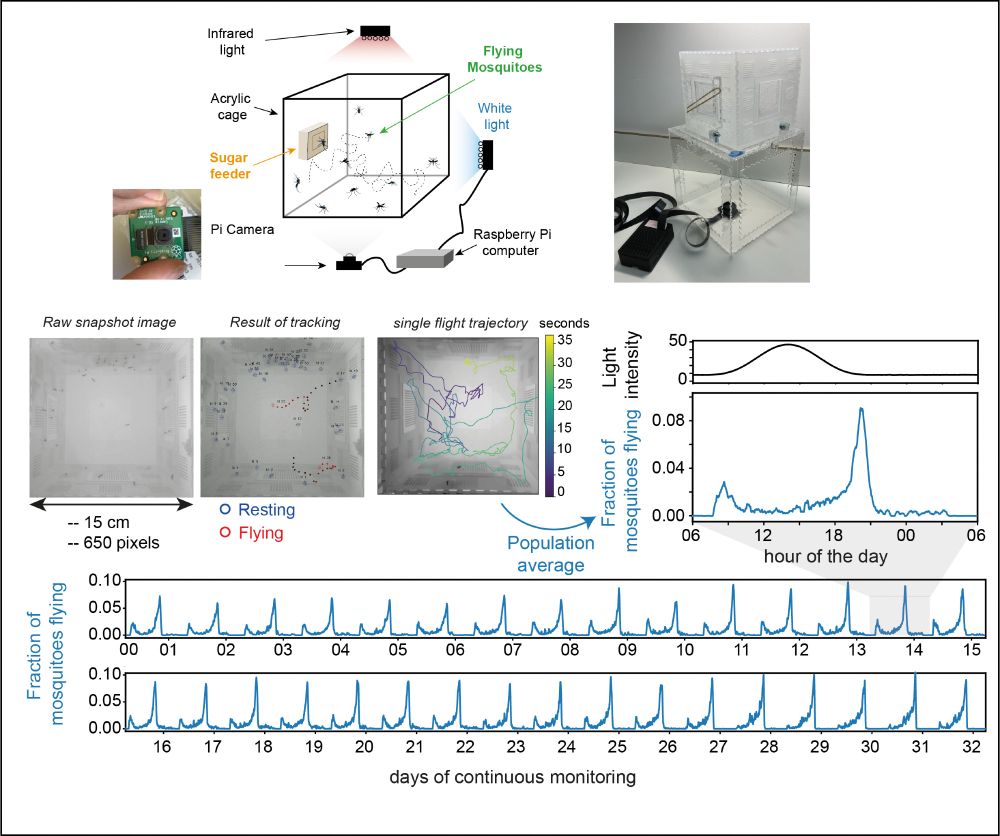
Starting in #RadboudUmc, our first goal is to make BuzzWatch portable enough to be transported by bicycle 🦟🚲🇳🇱.

Starting in #RadboudUmc, our first goal is to make BuzzWatch portable enough to be transported by bicycle 🦟🚲🇳🇱.
Also credits to Zhong Wan, Phd student with Felix Hol at RadboudUMC who carried all the experiments and analysis with Anopheles and was played a key role in developing the method, especially the Dutch version!
More news on that soon!

Also credits to Zhong Wan, Phd student with Felix Hol at RadboudUMC who carried all the experiments and analysis with Anopheles and was played a key role in developing the method, especially the Dutch version!
More news on that soon!
theomaire.github.io/buzzwatch/
and don't hesitate to contact me or Felix!
theomaire.github.io/buzzwatch/
and don't hesitate to contact me or Felix!
Ae. aegypti showed a 2-fold higher response during the day than at night (expected from a day biting mosquito:) ), although spontaneous flight activity without host cues was nearly the same and close to zero at those times !

Ae. aegypti showed a 2-fold higher response during the day than at night (expected from a day biting mosquito:) ), although spontaneous flight activity without host cues was nearly the same and close to zero at those times !

Mosquitoes quickly adapted with a new complex rhythm but also showed subtle shifts over time.
This is most striking in the PCA graph, where each dot represents a single day!

Mosquitoes quickly adapted with a new complex rhythm but also showed subtle shifts over time.
This is most striking in the PCA graph, where each dot represents a single day!
➡️ Answer: Yes, but only partially.
Overall, the effects of blood-feeding and egg-laying are small, yet consistent and measurable.

➡️ Answer: Yes, but only partially.
Overall, the effects of blood-feeding and egg-laying are small, yet consistent and measurable.
➡️Following a 2-day period of full rest, we observed subtle changes in their daily rhythm.
➡️Interestingly, these changes were long-lasting and showed no sign of gradual decline.

➡️Following a 2-day period of full rest, we observed subtle changes in their daily rhythm.
➡️Interestingly, these changes were long-lasting and showed no sign of gradual decline.
➡️Ae. aegypti (Aaa and Aaf)
➡️Ae. albopictus
➡️An. stephensi, gambiae, and coluzzi
PC1 represents day vs. night activity, while PC2 indicates total activity.

➡️Ae. aegypti (Aaa and Aaf)
➡️Ae. albopictus
➡️An. stephensi, gambiae, and coluzzi
PC1 represents day vs. night activity, while PC2 indicates total activity.
➡️A "local" tool resembling a "barcode" for easy comparison of different features (e.g. sugar feeding)
➡️A "global" tool using dimensional reduction on daily profiles
Both confirmed that "Aaa" is distinct due to increased midday activity!

➡️A "local" tool resembling a "barcode" for easy comparison of different features (e.g. sugar feeding)
➡️A "global" tool using dimensional reduction on daily profiles
Both confirmed that "Aaa" is distinct due to increased midday activity!
➡️the globally invasive subspecies "Aaa" is more active (fly more) during midday compared to the African "Aaf," but not during the morning or evening peaks.

➡️the globally invasive subspecies "Aaa" is more active (fly more) during midday compared to the African "Aaf," but not during the morning or evening peaks.


➡️Use laser cut acrylic, Raspberry Pi computer, cheap cameras, glue and white paper!
Instructions and templates are gathered here :
theomaire.github.io/buzzwatch/co...
otherwise feel free to contact me or Felix directly!
➡️Use laser cut acrylic, Raspberry Pi computer, cheap cameras, glue and white paper!
Instructions and templates are gathered here :
theomaire.github.io/buzzwatch/co...
otherwise feel free to contact me or Felix directly!
1. Automatically film mosquitoes in a transparent cage continuously, at 25 FPS, for several weeks (low resolution, about 10GB/day)
2.Analyze each 20-minute segment independently to track flying and resting mosquitoes
3.Extract flight and sugar feeding activity over weeks

1. Automatically film mosquitoes in a transparent cage continuously, at 25 FPS, for several weeks (low resolution, about 10GB/day)
2.Analyze each 20-minute segment independently to track flying and resting mosquitoes
3.Extract flight and sugar feeding activity over weeks

